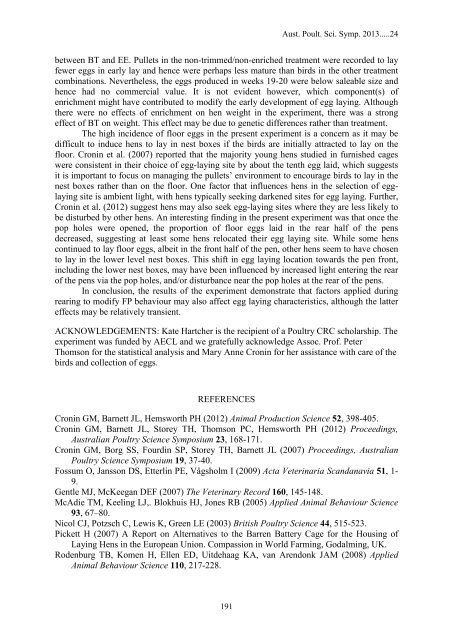APSS 2013 Proceedings - The University of Sydney
APSS 2013 Proceedings - The University of Sydney
APSS 2013 Proceedings - The University of Sydney
You also want an ePaper? Increase the reach of your titles
YUMPU automatically turns print PDFs into web optimized ePapers that Google loves.
Aust. Poult. Sci. Symp. <strong>2013</strong>.....24<br />
between BT and EE. Pullets in the non-trimmed/non-enriched treatment were recorded to lay<br />
fewer eggs in early lay and hence were perhaps less mature than birds in the other treatment<br />
combinations. Nevertheless, the eggs produced in weeks 19-20 were below saleable size and<br />
hence had no commercial value. It is not evident however, which component(s) <strong>of</strong><br />
enrichment might have contributed to modify the early development <strong>of</strong> egg laying. Although<br />
there were no effects <strong>of</strong> enrichment on hen weight in the experiment, there was a strong<br />
effect <strong>of</strong> BT on weight. This effect may be due to genetic differences rather than treatment.<br />
<strong>The</strong> high incidence <strong>of</strong> floor eggs in the present experiment is a concern as it may be<br />
difficult to induce hens to lay in nest boxes if the birds are initially attracted to lay on the<br />
floor. Cronin et al. (2007) reported that the majority young hens studied in furnished cages<br />
were consistent in their choice <strong>of</strong> egg-laying site by about the tenth egg laid, which suggests<br />
it is important to focus on managing the pullets’ environment to encourage birds to lay in the<br />
nest boxes rather than on the floor. One factor that influences hens in the selection <strong>of</strong> egglaying<br />
site is ambient light, with hens typically seeking darkened sites for egg laying. Further,<br />
Cronin et al. (2012) suggest hens may also seek egg-laying sites where they are less likely to<br />
be disturbed by other hens. An interesting finding in the present experiment was that once the<br />
pop holes were opened, the proportion <strong>of</strong> floor eggs laid in the rear half <strong>of</strong> the pens<br />
decreased, suggesting at least some hens relocated their egg laying site. While some hens<br />
continued to lay floor eggs, albeit in the front half <strong>of</strong> the pen, other hens seem to have chosen<br />
to lay in the lower level nest boxes. This shift in egg laying location towards the pen front,<br />
including the lower nest boxes, may have been influenced by increased light entering the rear<br />
<strong>of</strong> the pens via the pop holes, and/or disturbance near the pop holes at the rear <strong>of</strong> the pens.<br />
In conclusion, the results <strong>of</strong> the experiment demonstrate that factors applied during<br />
rearing to modify FP behaviour may also affect egg laying characteristics, although the latter<br />
effects may be relatively transient.<br />
ACKNOWLEDGEMENTS: Kate Hartcher is the recipient <strong>of</strong> a Poultry CRC scholarship. <strong>The</strong><br />
experiment was funded by AECL and we gratefully acknowledge Assoc. Pr<strong>of</strong>. Peter<br />
Thomson for the statistical analysis and Mary Anne Cronin for her assistance with care <strong>of</strong> the<br />
birds and collection <strong>of</strong> eggs.<br />
REFERENCES<br />
Cronin GM, Barnett JL, Hemsworth PH (2012) Animal Production Science 52, 398-405.<br />
Cronin GM, Barnett JL, Storey TH, Thomson PC, Hemsworth PH (2012) <strong>Proceedings</strong>,<br />
Australian Poultry Science Symposium 23, 168-171.<br />
Cronin GM, Borg SS, Fourdin SP, Storey TH, Barnett JL (2007) <strong>Proceedings</strong>, Australian<br />
Poultry Science Symposium 19, 37-40.<br />
Fossum O, Jansson DS, Etterlin PE, Vågsholm I (2009) Acta Veterinaria Scandanavia 51, 1-<br />
9.<br />
Gentle MJ, McKeegan DEF (2007) <strong>The</strong> Veterinary Record 160, 145-148.<br />
McAdie TM, Keeling LJ,. Blokhuis HJ, Jones RB (2005) Applied Animal Behaviour Science<br />
93, 67–80.<br />
Nicol CJ, Potzsch C, Lewis K, Green LE (2003) British Poultry Science 44, 515-523.<br />
Pickett H (2007) A Report on Alternatives to the Barren Battery Cage for the Housing <strong>of</strong><br />
Laying Hens in the European Union. Compassion in World Farming, Godalming, UK.<br />
Rodenburg TB, Komen H, Ellen ED, Uitdehaag KA, van Arendonk JAM (2008) Applied<br />
Animal Behaviour Science 110, 217-228.<br />
191
















